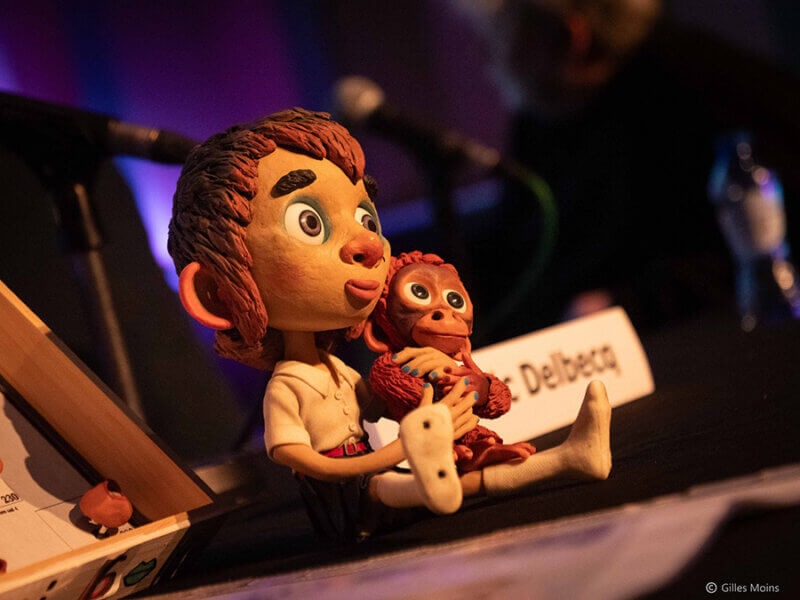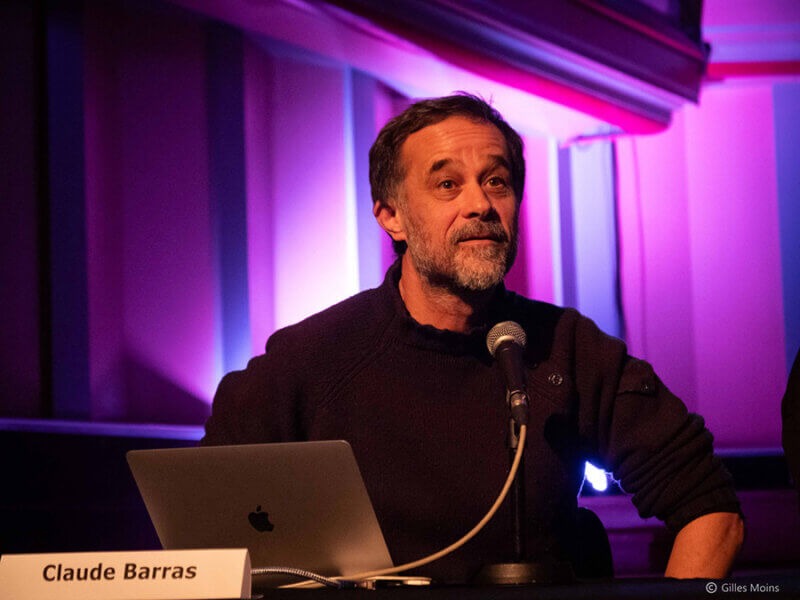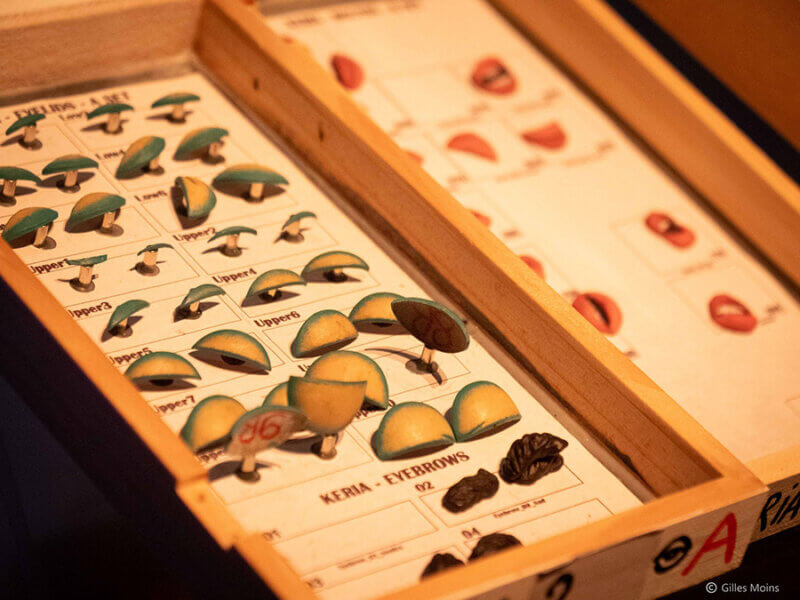From Borneo to Switzerland – Claude Barras’ Sauvages! unveiled at Anima 2024
During a two-hour session that felt like only a few minutes, Swiss artist Claude Barras and his team led a captivated audience through the journey that has been Sauvages!, the director’s latest feature. Skwigly had the chance to attend this making of, of which you can discover the full account.

Claude Barras’ Sauvages! unveiled at Anima 2024 © Gilles Moins (Source: Anima Festival)
It’s definitely scheduled to be one of the main events of the 2024 animated feature calendar. Sauvages!, the upcoming stop-motion feature by director Claude Barras (My Life as a Courgette), is due to be released in October this year in France, and will most likely be part of the Annecy 2024 competition.
And while Barras had already given some details about the plot, it was a pleasure to discover more about the film itself through a two-hour Making Of, courtesy of Anima 2024 and its Futuranima program. For those of you who may not be familiar with this major Belgian animation event, you can browse through our recap of this edition here.
The Sauvages! Making Of was definitely one of the highlights of this edition, with no less than five members of the team taking a captive audience through the whole production process, from script to sound design and more.
“It all started with my own childhood,” said Barras. “I wanted to tell a story about the relationship between man and nature, and how it has evolved over the last decades. I felt this shift through the lives of my grandparents, who were farmers like most people in their time. Today, less than 3% of the population are farmers, and we all know how hard it is for them in our society. While drawing my first characters, I discovered a Swiss activist called Bruno Mansard who worked with Bornean populations to defend their way of life, and their habitat. And that was the starting point of Sauvages.”
Barras worked for several years on the script with French co-writer Catherine Paillé, logging enormous amounts of research to make sure their depiction of Borneo was accurate and respectful of the local culture. Preparation and writing process included a 10-day trip to Borneo, loads of video footage and documentaries, and the help of two Bornean-born French musicians who provided assistance on the dialect sequences. “I couldn’t have done it otherwise”, underlined Barras, “it was essential for me to be able to depict truthfully this culture which is not my own, even if the story relates to my childhood.”

Claude Barras’ Sauvages! unveiled at Anima 2024 © Gilles Moins (Source: Anima Festival)
How will that translate into the film? “Dialogues in Penan won’t be subtitled, as it’s not something children would be able to follow, so we’ll be in the little girl’s point of view with translation made by the characters,” explained Barras, expanding on his choice.
Several sequences from the film were shown by the director to dive into the different steps of set building, coordinated by Jean-Marc Ogier (This Magnificent Cake!). A mesmerizing process from small clay models to full-scale sets built in Rennes, France, before they were sent to Switzerland for the shoot.
Head of Production Ludovic Delbecq (Panique! Productions) followed this introduction by taking an in–depth look at this particular co-production setting. European animators, puppeteers, French and Belgian puppets designers and French set builders all gathered in Martigny, Switzerland, for a 4-month shoot in a 2000-square meters empty storage unit, fully redesigned to fit the needs of this unique production. Sixteen full sets, two test sets and one demo-set were built, with 40 to 50 crew members working on site at the peak of production. Shooting took place from March 6 to late September, 2023. A 6-month period which, multiplied by the number of animators ranging from 2 to 10, represents a whopping 225 weeks of animation, according to Delbecq.
How was such a feat accomplished? Thanks to an amazing team, supervised by first assistant director Dorien Schetz, who had previously been working as Studio Production Manager at Belgian Beast Animation studio for more than a decade. With a delightful cheery tone, she took a captivated audience through her breaking sheets and full shooting schedule. “There are more than 800 shots in Sauvages, and it was essential to know, for each, how many puppets were to be used, how many animators, for how long, etc”, explained Schetz while taking us around her 80-columns wide Excel sheet, a both mesmerizing and nightmarish journey.

Claude Barras’ Sauvages! unveiled at Anima 2024 © Gilles Moins (Source: Anima Festival)
“But even with all this preparation”, she added, “there’s always a big difference between theory and reality. When you go into shoot, you have to know that there will be some changes along the way. What’s important to keep in mind is that every production is unique, and that everybody stays motivated and on board during the whole process. We had weekly meetings with the whole crew, daily meetings with Claude and second assistant director Clémence Pun, and many other meetings to make sure everything ran smoothly. And in the end, we pulled through! Thanks to a wonderful crew, and permanent communication through every department.”
Being a stop-motion feature, one of the most important of those units was the puppet division. Christine Polis, lead armatures and head of puppets hospital on set, went thoroughly through the lengthy process of creating the numerous characters that are present in the film. “We started in 2020 with my colleagues Gregory Beaussart [Head of Puppets] and Benoit Polveche [Rigging & armatures], and the first step was to go through all the characters and determine how they would look on screen. Between primary, secondary and tertiary characters, we tried to simplify some designs. But some of them, such as the Panther or the Calao, need to be heavily detailed even though they only appear a few minutes during the movie. After that rundown, we started creating armatures, molding and modeling processes. It’s a very complex and touchy process, because even with the best predictions, sometimes the materials don’t fit exactly and you have to start over. The tiniest difference can turn into a big issue for animators afterwards.” For heads and faces, the team went back to sculpture, after using a 3D printer technique on Courgette. “Here, we needed more textured material, as our puppets were heavily detailed,” commented Polis. “We used 3D to print eyes and other parts, but each face had to be sculpted. It took us a lot of time, but the result was worth it.”.
As the shooting started, every piece of the film was brought to Martigny, along with their makers. Polis continued to monitor puppet consistency during the whole process, fixing costumes – which were made in Rennes also – and characters so animators could continue their meticulous work easily. “Each puppet had to be set-ready according to schedule, with every hair or costume detail. They all traveled in precise boxes, in order to be fully functional and yet adaptable. When a character needs to have a little dirt, or a drop of blood on his face, we have to find ways to remove it after the shot, as we cannot lose a head or a hand only because they’ve been dirtied a bit.” Did somebody say stop motion was easier than drawing?
To conclude this fascinating presentation, sound editor and composer Charles De Ville described how he managed to create this very particular atmosphere for the film, mixing bank sounds with real recordings made in the Bornean jungle. “After a lot of research, the production and I agreed that we had to make some recordings ourselves, in order to fully portray the complexity and the beauty of this nature. I had the chance to spend two weeks on site, and brought a huge amount of samples back home. What must be understood,“ continued De Ville, “is that when you walk in the jungle, every creature has her own sound and it creates a heavily layered background, which becomes even more complex at night. In order to create an understandable and relatable atmosphere for Sauvages!, I isolated some of these sounds through their frequencies, recreating our own sound puzzle to serve the story and the ambiance of Claude’s film. Each scene, each scenery has its own soundscape. To create the music, we went further with those sounds and sampled them, before linking them to specific notes on my keyboard. I was then able to play them as you would a piano, and create this unique soundtrack.”

